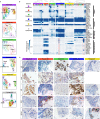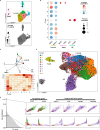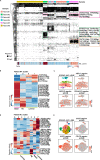Single-cell analysis supports a luminal-neuroendocrine transdifferentiation in human prostate cancer
- PMID: 33328604
- PMCID: PMC7745034
- DOI: 10.1038/s42003-020-01476-1
Single-cell analysis supports a luminal-neuroendocrine transdifferentiation in human prostate cancer
Abstract
Neuroendocrine prostate cancer is one of the most aggressive subtypes of prostate tumor. Although much progress has been made in understanding the development of neuroendocrine prostate cancer, the cellular architecture associated with neuroendocrine differentiation in human prostate cancer remain incompletely understood. Here, we use single-cell RNA sequencing to profile the transcriptomes of 21,292 cells from needle biopsies of 6 castration-resistant prostate cancers. Our analyses reveal that all neuroendocrine tumor cells display a luminal-like epithelial phenotype. In particular, lineage trajectory analysis suggests that focal neuroendocrine differentiation exclusively originate from luminal-like malignant cells rather than basal compartment. Further tissue microarray analysis validates the generality of the luminal phenotype of neuroendocrine cells. Moreover, we uncover neuroendocrine differentiation-associated gene signatures that may help us to further explore other intrinsic molecular mechanisms deriving neuroendocrine prostate cancer. In summary, our single-cell study provides direct evidence into the cellular states underlying neuroendocrine transdifferentiation in human prostate cancer.
Conflict of interest statement
The authors declare no competing interests.
Figures








References
Publication types
MeSH terms
LinkOut - more resources
Full Text Sources
Other Literature Sources
Medical
Molecular Biology Databases

